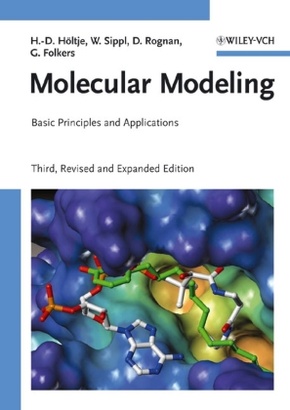Molecular Modeling - Basic Principles and Applications
| Verlag | Wiley-VCH |
| Auflage | 2008 |
| Seiten | 310 |
| Format | 17,2 x 1,7 x 24,2 cm |
| Gewicht | 610 g |
| Artikeltyp | Englisches Buch |
| ISBN-10 | 3527315683 |
| EAN | 9783527315680 |
| Bestell-Nr | 52731568A |
Umfassend und präzise, besonders für Anfänger gut verständlich: Dieser Band erklärt die Grundlagen der Molekülmodellierung kompetent und nachvollziehbar. Ausführlichen Informationen zur Modellierung von kleinen Molekülen und Proteinen folgen durchgearbeitete Beispiele, die dem Leser den Weg zum ersten eigenen Experiment ebnen. Neu in dieser dritten Auflage ist ein Kapitel zur Chemogenomik, das (gemeinsam mit dem überarbeiteten und erweiterten Beispiel zur Behandlung komplizierterer Biomoleküle) den gegenwärtigen Trend zur "chemischen Biologie" widerspiegelt.
Die Autoren, erfahrene Dozenten in diesem Themenbereich, garantieren die Praxistauglichkeit des Bandes als Begleiter einschlägiger Vorlesungen. Für Fachleute interessant: Als einziges gegenwärtig erhältliches Werk enthält das Buch einen systematischen Vergleich der Möglichkeiten und Grenzen moderner MM-Verfahren und entsprechender Software-Pakete.
Ideal for beginners, this book explains the basics of modeling in a competent yet easily understandable way. Following complete sections on the modeling of small molecules, protein modeling and chemogenomics, completely worked-out examples show the way to the reader's first modeling experiment.
This new, third edition features a new chapter on chemogenomics, reflecting the trend towards 'chemical biology', as well as the protein modeling example being completely rewritten for a better 'feel' of modeling complex biomolecules.
The authors are experienced university teachers who regularly hold courses on molecular modeling, making this a tried-and-tested text for teachers. It is equally valuable for experts, since it is the only book to evaluate the strengths and limitations of the molecular modeling techniques and software currently available.
Inhaltsverzeichnis:
Introduction
Small Molecules
- Generation of 3D-Coordinates
- Computational Tools for Geometry Optimization
- Conformational Analysis
- Determination of Molecular Interaction Potentials
- Pharmacophore Identification
- 3D QSAR Methods
A Case Study for Small Molecule Modeling: Dopamine D3 Receptor Antagonists
- Building a Pharmacophore Model
- 3D QSAR Analysis
Introduction to Comparative Protein Modeling
- Where and How to get Information on Proteins
- Terminology and Principles of Protein Structure
- Comparative Protein Modeling
- Optimization Procedures - Model Refinement - Molecular Dynamics
- Validation of Protein Models
- Properties of Proteins
Virtual Screening and Docking
- Preparation of the Partners
- Docking Algorithms
- Scoring Functions
- Postfiltering Virtual Screening Results
- Comparison of Different Docking and Scoring Methods
- Examples of successful Virtual Screening Studi es
Scope and Limits of Molecular Docking
- Docking in the Polar Active Site that Contains Water
- Including Cofactor in Docking? (NEW)
- Impact of Tautomerism on Docking (NEW)
Chemogenomic Approaches to Rational Drug Design (NEW)
- Description of Ligand and Target Spaces
- Ligand-based Chemogenomic Approaches
- Targed-based Chemogenomic Approaches
- Target-Ligand Based Chemogenomic Approaches
A Case Study for Protein Modeling: the Nuclear Hormone Receptor CAR as an Example for Comparative Modeling and the Analysis of Protein-Ligand Complexes (NEW)
- The Biochemical and Pharmacological Description of the Problem
- Comparative Modeling of the Human Nuclear Hormone Receptor CAR
- Analysis of the Models that Emerged from MD Simulations
- Analysis of CAR Mutants
- Modeling of CAR-Ligand Complexes
- The CAR X-Ray Structure Comes into Play
- Virtual Screening for Novel CAR Activators
Rezension:
"Beginners as well as experts in the field of biochemistry, molecular biology, and drug development will find this book quite handy and useful. The third edition is justified given the rapid development of hardware and software tools and other advances in the applications of molecular modeling techniques." ( Doody s, April 2009)
"The authors are experienced university lecturers and as a result of their teaching practices the textbook provides teachers with a tried-and-tested learning material. The text is equally valuable to experts" (International Journal of Bioautomation , April 2009)
"An excellent resource as an introduction to molecular modelling techniques ... .I can particularly recommend this book to academics." ( Journal of Medicinal Chemistry , September 2008)

